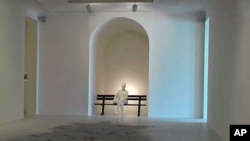The September 11 terror attacks may have changed our view, even of objects created before 9/11/2001. A new exhibit at the Museum of Modern Art’s branch in New York’s Long Island City explores this idea. The exhibit features pieces made years before the attacks, which seen in a new context, find different meanings and responses.
Those who remember New York on the days following the 9/11 terrorist attacks are familiar with scenes like this - impromptu memorials to loved ones. The shrine on this street corner, however, is an art installation from 1997 by Swiss born artist Thomas Hirschhorn, called "Mondrian Altar."
"Mondrian Altar" is part of an exhibit called "September 11" at the Museum of Modern Art’s Queens outpost, PS1. But while the exhibit opened on the 10th anniversary of the attacks, most of the pieces in it were created before the attacks took place.
Altered perception
On the morning of September 11, 2001, in this very space at PS1, Canadian artist Janet Cardiff had mounted her experimental installation "The Forty Part Motet" using 40 speakers - each representing a member of a choir, singing a mournful piece of medieval English church music.
Now, 10 years later, PS1 has re-installed the piece as part of its effort to show the effect of the attack on our perceptions - even of things that came before it.
For example, in this landscape painted 15 years before 2001, we can’t avoid seeing the shadow of the Twin Towers.
Changing everything
This documentary by artist Jem Cohen is about a victory parade that celebrated the return of American troops after the 1991 Gulf War. But the film of that victory parade 10 years before 9/11 reminds the viewer of the September 11 attacks.
"What we saw in 1991 was a reaction of extreme nationalism, pride and patriotism," said Cohen. "In 2001, those events reshaped the piece. It indicated that sometimes we made historical documents that we don’t control."
The only piece directly pointing to 9/11 is a collage by American artist Ellsworth Kelly. The show's creator, PS1 curator Peter Eleey, said the approach in this simple collage is what he wanted to extend to the entire show.
"I was interested how particularly Kelly’s approach allows us to look differently at this location, which for us was so sort of marred by the violence that occurred there," said Eleey. "And I began to think about how an exhibition could offer something similar by looking differently, that we could in a sense create our own meaning, if I could expand the context within which we consider 9/11."
With this approach, the PS1 exhibit revives, renews and enlivens art pieces of the recent past - art that had become either too familiar and commonplace - or had been forgotten, like this crushed car from 1982 by sculptor John Chamberlain, which now stands for the violence of that day.
Looming shadows
Another piece from 1980, by American artist Sarah Charlesworth, stands for the heart-wrenching scenes that were repeated 20 years after it was made.
"There were seven blowups like this, and they were all taken from newspaper photos of people jumping, obviously the association that people are going to have about that day. I had to consider whether it altered the meaning of the work too much," said Charlesworth.
Newspaper photos also are the subject of another installation that covers the walls of a large hall.
"This is the work by a Dutch artist named Willem De Rooji. It's an archive of images he cut out of newspapers beginning early in 2000, continuing through mid-2002," said Eleey.
Moving exhibit
This otherwise pleasant shot of a sunny day on a plane takes on an ominous meaning and identity, when we consider the crash of planes full of fuel and people into the tall buildings.
Presiding over the central hall of the exhibition is a piece by New York sculptor George Segal, who died a year before 9/11. Segal’s woman looks down at a grey powder which covers the entire floor.
"It’s in fact pulverized passenger jet engine by the British artist Roger Hiorns, which he sent to an industrial company that ground it into a very fine powder - mostly aluminum and steel," said Eleey.
The exhibit continues at PS1 through January 9 of next year.









